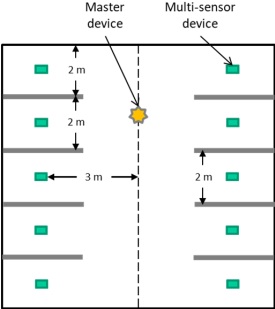Reference no: EM132263071
An enterprise that uses a commercial space of 10 offices aims to develop a smart office IoT system to lower the cost of electricity. To this end, multi-sensor devices that monitor the temperature and light level (as well as appropriate actuators) will be placed in each office. Each of the multi-sensor devices supports a Bluetooth Classic (v1.x) connection. Assume that Bluetooth devices acting as a Master device can be deployed in the corridor as shown in the office layout.
Determine
a. how many Master devices and, therefore, how many piconets are needed in order to form a scatternet connecting all of the multi-sensor devices.
b. Identify an appropriate location (or range of locations) for the Master device(s) assuming that i) the maximum sensitivity of any slave multi-sensor device is -max [(∑xi), 60] dBm,
ii) the appropriate path loss model is considered for determining the received power,
iii) the transmitting power of the devices is class II for both the multi-sensor devices and the Master device(s), and iv) the Master Device(s) can only be placed along the dashed line as shown in the office layout.
• Revisit the above questions where the receivers have a sensitivity determined as
- max [((∑xi) + 5), 47].
To determine the received power at distance d, consider the following:
i) the gain of the antennas for all of the devices (GTX, GRX) is 1,
ii) the hardware loss coefficient, L is equal to 1,
iii) a Master device cannot serve as a slave for another piconet,
iv) all slave devices are continually active, and
v) to determine the sensitivity of the receiver of a slave node, (∑xi) is the summation of the digits of your student ID.
Also, the sensitivity of the receiver of the Master devices(s) is -80 dBm and, thus, receiving data from the transmitter of the slave devices is rather satisfied for any location of the Master.

Figure 1: Office layout